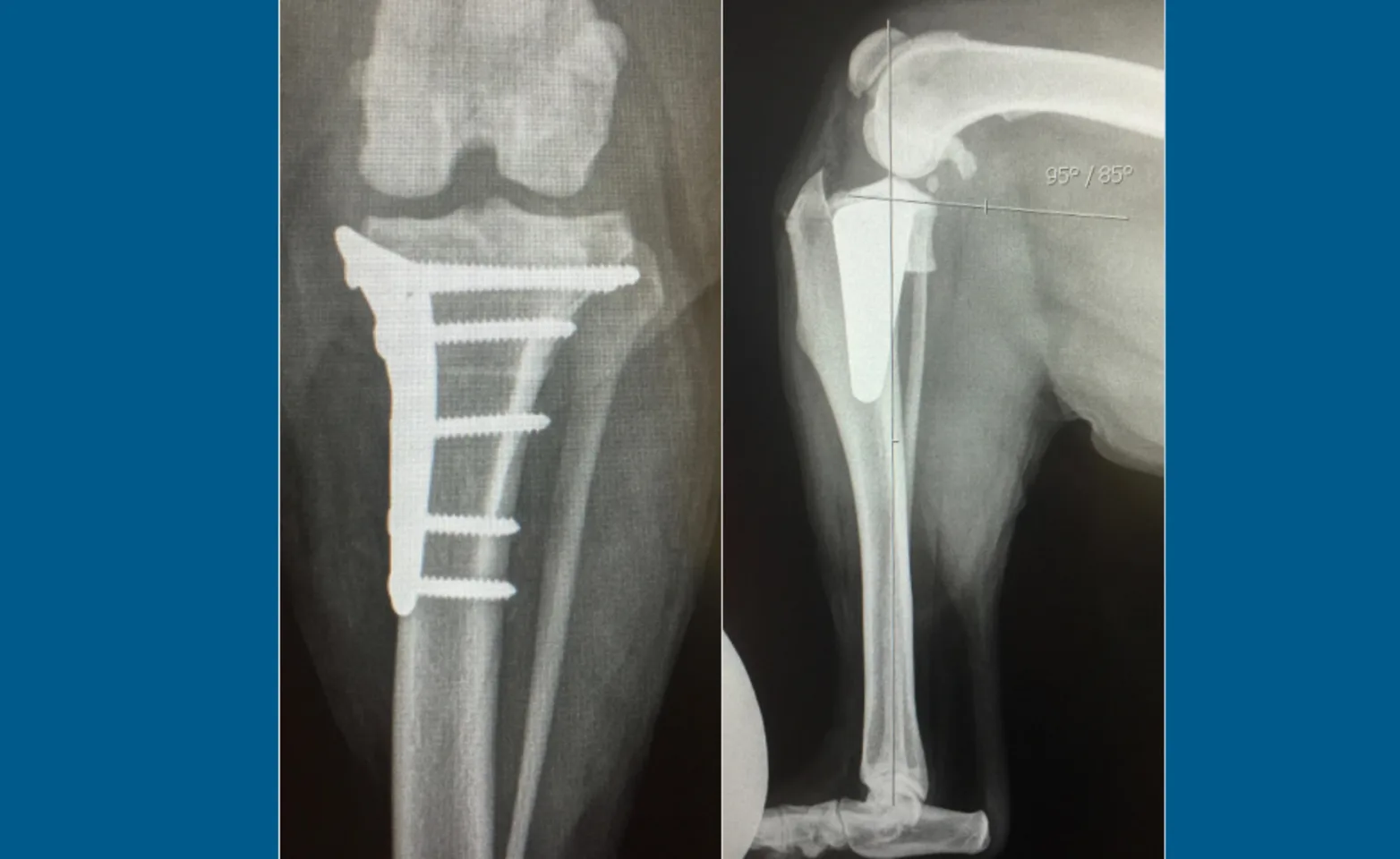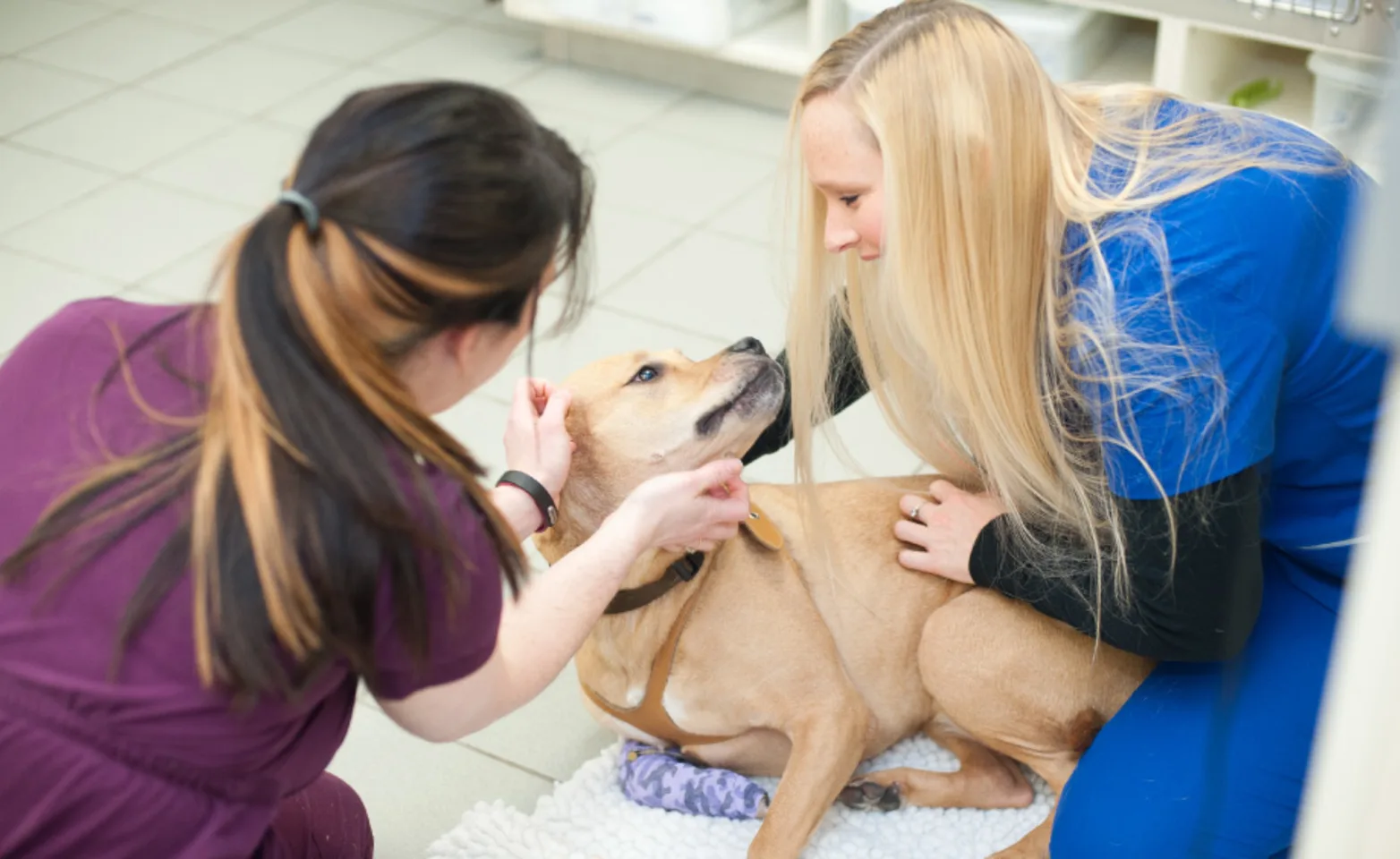Veterinary Emergency and Referral Hospital of West Toronto
Rupture of the Cranial Cruciate Ligament
Rupture of the cranial cruciate ligament (CCL)is one of the most common orthopedic injuries in the dog. Ruptures may be a result of trauma or a progressive degenerative condition (inherited in some cases). In cases of chronic degeneration, up to 50% of these patients may rupture the cruciate ligament in the opposite hind leg within 2 years. Rupture of the cruciate ligament results in instability of the stifle (knee joint) causing pain, lameness, and progressive arthritis.
Chronic instability may also result in damage to the menisci (“cushions” within the joint). The meniscus is evaluated at surgery and if damaged, the abnormal portion will be removed. If the meniscus is normal a meniscal release may be preformed.
Diagnosis
A presumptive diagnosis of a cranial cruciate ligament injury is based on the physical exam. Common findings may include pain localized to the stifle, joint effusion (swelling), medial buttress (scar tissue) formation, and detection of instability in the joint (cranial drawer sign) . The cranial drawer sign may not be obvious with CCL injuries due to the incomplete tearing or chronic changes within and around the joint. Furthermore, electing a positive drawer sign can be difficult if the patient is overly tense or nervous. Sedation may be recommended for assessment of some patients. Radiographs are generally advised to rule out other causes of lameness although the cruciate ligaments are not visible. Radiographs are useful to evaluate the stifle joint for swelling and arthritis secondary to the cruciate rupture, and to evaluate the tibial slope (for the TPLO procedure). An MRI can also be used to visualize the cruciate ligaments, however it does require general anesthesia.
Treatment Options
Stifle instability caused by rupture of the cranial cruciate ligament will cause progressive arthritis and in most cases, a persistent lameness with an inability to return to normal activity without surgical intervention. On occasion, small breed dogs (less then 20lbs) and cats will return to acceptable levels of function after 4 to 8 weeks of strict rest. However, most animals will eventually develop advanced arthritis if surgery is postponed for too long or if it is not performed at all. The longer surgery is postponed the chances of meniscal injury will increase, and the benefits of surgery will be diminished.
Extracapsular Cruciate Repair
Extracapsular cruciate repair techniques eliminate cranial drawer movement (joint laxity) by placement of a heavy gauge suture from around the fabella (a small bone behind the knee joint) to a hole placed in front of the tibia. This procedure ultimately relies on scar tissue formation to achieve joint stability. Postoperative restrictions are crucial to the success of this surgery. Many dogs return to roughly 75% function on the limb, which is usually acceptable for non-working dogs. Small dogs and cats often recover better with this surgery due to a slight difference in the biomechanics of their legs.

Tibial Plateau Leveling Osteotomy (TPLO)
The tibial plateau levelling osteotomy (TPLO) eliminates the need for the cruciate ligament by levelling the surface of the tibia (the bone below the knee joint) without disturbing the cartilage. A semicircular, full thickness cut in the tibia is performed and the piece is rotated so that the surface is close to the perpendicular to the tibia. The bone is then stabilized with a bone plate and screws. The outcome following the TPLO is characterized by the early return to weight-bearing function and durable, lifelong repair. The prognosis is good to excellent, giving the best chance for resumption of normal activities for dogs with an active or working lifestyle including those with other concurrent orthopedic problems

Cruciate Ligament Tears in Cats
Cruciate ligament ruptures are rare in cats. Conservative treatment with restricted activity and weight loss (for obese cats) may result in a full return to function of the leg without surgery in an average of 4 to 8 weeks. Surgery is indicated in cats with lameness persists despite conservative treatment, or if other orthopedic conditions are present. In either case, the prognosis for cats with cruciate ligament injuries is very good.
Postoperative Care & Prognosis
During the first 24 to 48 hours following surgery, icing the surgical incision (cryotherapy) combined with compression results in decreased pain, swelling and in inflammation for the patient. A small bandage will cover the incision for the first few days. Sutures are commonly internal/absorbable for this procedure. Although if non-absorbable sutures or staples are used they require removal 10 to 14 days after surgery. Rehabilitation after surgery helps result in a quicker return to normal function and ensures an optimal recovery. After surgery, dogs are restricted to very short leash walks only for two weeks then slowly increased to two twenty minute leash walks for at least 6 to 8 weeks.
Running, jumping or play sessions with other people or pets are not allowed during the recovery period. A recheck exam is performed in 6 to 8 weeks after surgery. Dogs treated with the TPLO procedure require radiographs to confirm bone healing at the 8 week recheck exam. Most dogs return to normal activity within 3 to 4 months of surgery.
Although all dogs will develop some arthritis, most dogs return to full activity. There are many treatment options available to relieve the symptoms of arthritis (nutriceuticals, anti-inflammatory medications, conservative exercise, weight control, prescription diets, acupuncture, etc.) Owners may report occasional lameness or stiffness in the leg, particularly after extended activity, after lying down for lengthy periods, or in very cold weather. Dogs treated with the TPLO have good to excellent clinical function once recovered. Complications are uncommon with these procedures.
